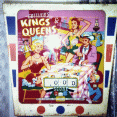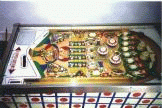



Kings & Queens is an Electro-Mechanical pinball table, manufactured in 1965 by D. Gottlieb and Co. of Chicago, Illinois.
Launched in March 1965, Kings and Queens is a good example of the kind of table that made Gottlieb famous. The game is colourful, easy to play, and above all is fun. It's an electro-mechanical game; it has no electronic components. Inside are dozens of switches, relays and solenoids, over a hundred bulbs and a few bells. The logic which controls it is purely mechanical, and is rather impressive to look at. It bears as much relation to modern day pinball as ferrite core does to a 16Mb SIMM.
Kings & Queens had a starring role in the film Tommy,
when Roger Daltry finds a machine abandoned in a dump. (Though
curiously with the power cable still connected!)
In the centre of the playfield is a 4X4 matrix, reprisenting the 16 picture cards. They are arranged from left to right as Ace to Jack, and from top to bottom as Hearts, Spades, Diamonds and Clubs. Around the table are arranged 16 "rollovers", each of which scores 5 points and lights the appropriate card in the matrix.
The object of the game is to get the ball into the four saucers, which are located in a line accross the centre of the field. Each saucer is worth 10 points, plus a further 10 points for each of the cards of that rank which have been lit. The saucer then kicks the ball out to the right, hopefully into the next saucer. The "Jacks" saucer kicks the ball down towards the flippers.
Once all four cards of the same rank have been lit, the saucer may light up for Special. Getting the ball into the saucer when it is lit awards one replay. Once all four Clubs are lit, the top centre rollover may light for Special. This is quite rare, however; it is also difficult to get, as to light both the Ace and the Jack of Clubs requires that you lose the ball in play!
The machine can register scores of up to 999 on its three score reels. The first time this is exceeded, a light illuminates a 1000 digit. The highest score that the machine can register is therefore 1,999. Recently I managed to beat this, with a score of 2,042 on a 5 ball game.
Replay scores are configurable. I've currently got them set for 800,
then every 200 points. You can also set it up for 3 or 5 ball play; I
have it set for 5 ball. The rules are slightly different in 3 ball
play; certain rollovers spot two cards instead of one.
Lots of people ask about how I got it; the fact is I was very lucky. It was built for a company called Mondial, for export only - there is a plate to that effect on the front of it. At some stage in its life it was clearly in an amusement arcade somewhere. It originally cost 6d to play, but when Britain went decimal in 1971 (remember those programs on BBC1 just before the 6pm News, and that song by The Scaffold?) it was converted to 2p play.
At some stage it passed into private ownership, and found its way to the second floor of a large house in Bolton. When the present occupant bought the house, he found that the machine had been left behind. His children played with it (and generally mistreated it), but got bored as by now it didn't work too well.
I heard about the machine quite by chance. I went round and took a look at it; it wasn't in great condition, but I offered him £50 for it and he accepted. Since then I've paid about £50 more on spare parts and clean rubbers. I'm still waiting for a schematic diagram and a new coil for the left hand flipper; being 30 years old, spares are hard to come by!
I've cleaned it up a bit, but it's still very dirty inside. I even found half an old cigar in there! The playfield is very worn in several places, and the flippers have cut quite deep gouges into the wood. Some of the bulb holders have poor connections, which means that the lights glow dimly or even not at all. But I've cleaned up the playfield a bit and made a number of repairs, and now it's playing reasonably well.
Take a look inside the machine.
The company was formed around 1930. In those days, pinball was more
like the game we call Bagatelle; you had a fixed number of balls and
the object was to land them in certain areas of the playfield. Each
area scored a different number of points, and it was up to the player
to add up his or her score.
After WWII, Gottlieb introduced a new machine called Humpty
Dumpty. This revolutionised the game of pinball overnight, because
it introduced a new gadget known as the "flipper". Using the flipper,
the player could now interact with the ball in play. Companies
immediately began to design new "flipper pinball" games, and to
retro-fit flippers into existing games. Gottlieb, and the rival
company Williams, were the two biggest manufacturers of
pinball tables throughout the 50s and 60s. In the mid 1970s, the
Gottlieb family sold the company, together with the rights to the
Gottlieb name.
Nowadays the name is owned by a company called Premier,
who continue to produce games. Howerver, they now have a much smaller
share of the market behind Williams (who also produce
games under the name Bally, having merged with the
company some years ago) and Data East, a relative
newcomer.